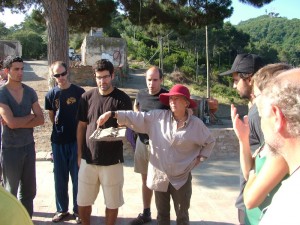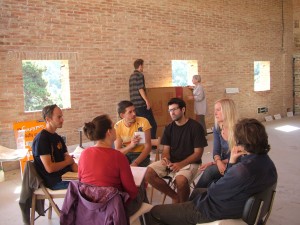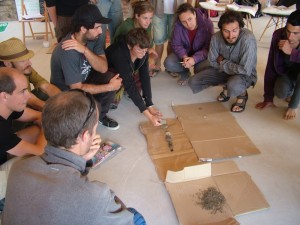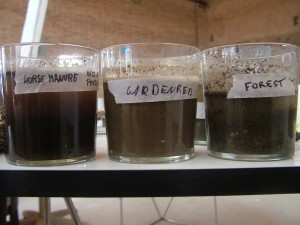” Heaven is under our feet as well as over our heads” Today we began the day talking about climate and microclimates. Climate is the patterns of the weather in a particular area across time, with our designs we want to minimize the climate extremes to reduce or avoid climatic disasters, especially in an age of climate change. Climate change is generating changes in the precipitation patterns and distribution and also affecting plants’ photoperiod. Climate affects our designs in three major elements: – Wind: it shapes & prunes trees, is a source of energy, transports things… – Precipitation: cleans, hydrates, shapes the landscape, retains energy, erodes, gives life… – Radiation: controls the cycles in nature, sterilizes, causes evapotranspiration, heat… In our lands we work with microclimates because it is not difficult to change and manage them. Microclimates have 5 elements that we can manage directly: vegetation, structures, water, soils and topography: – Topography: aspect and slope. We can generate thermal zones, cold sink, sun traps… – Vegetation: forest moderate temperature and increases moisture… – Structures: passive thermal design, bioclimatic houses… – Soil types: warm dry, cold moist… – Water: light reflection 
 After this two sessions we had lunch and a little time to relax. After that, Rosemary and Alfred taught us in a very dynamical way how to recognize a good and fertile soil. We split into different groups to perform a soil test. We had to analyze the structure, texture, tilth (how the top soil is, good or bad), percolation (how quickly water soaks in), pH (are nutrients available to plants), humus (decomposed organic matter that becomes humic acid, which in turn can hold water and nutrients, and give them back to plants when they need it), peds (soil should have light ped structure), OM, porosity, salination. Other way to analyze it is making use of the traditional soil classification:
After this two sessions we had lunch and a little time to relax. After that, Rosemary and Alfred taught us in a very dynamical way how to recognize a good and fertile soil. We split into different groups to perform a soil test. We had to analyze the structure, texture, tilth (how the top soil is, good or bad), percolation (how quickly water soaks in), pH (are nutrients available to plants), humus (decomposed organic matter that becomes humic acid, which in turn can hold water and nutrients, and give them back to plants when they need it), peds (soil should have light ped structure), OM, porosity, salination. Other way to analyze it is making use of the traditional soil classification:
- colour: white to black
- vegetation: what is growing
- parent material: bedrock
- smell: sour (sulfure dioxide), sweet or soapy (acid), calcium (hard)
- soil life
- how it manages water: does it drain within 24h
- history: how was it, how did it change

 To work with soils there are three key points: use appropriate soil restoration strategies, have it covered always, and add more organic matter than what we remove. If we understand the soil as a living organism we need to avoid certain practices that are common place in industrial agriculture. Like removal of surface vegetation (plowing), the application of chemical fertilizer, the accumulation of biocides, the salinization (white death) due to vegetation clearing and irrigation and inappropriate farming methods (monoculture, heavy machinery, draining wetlands) To repair a degradet soil we need first of all bring water in to allow the life, there are different techniques to get it for example, landshapping (terraces, swales), cover the soil, bringing back vegetation and improving soil qualities putting organic matter.
To work with soils there are three key points: use appropriate soil restoration strategies, have it covered always, and add more organic matter than what we remove. If we understand the soil as a living organism we need to avoid certain practices that are common place in industrial agriculture. Like removal of surface vegetation (plowing), the application of chemical fertilizer, the accumulation of biocides, the salinization (white death) due to vegetation clearing and irrigation and inappropriate farming methods (monoculture, heavy machinery, draining wetlands) To repair a degradet soil we need first of all bring water in to allow the life, there are different techniques to get it for example, landshapping (terraces, swales), cover the soil, bringing back vegetation and improving soil qualities putting organic matter.